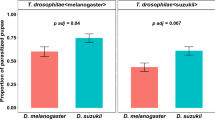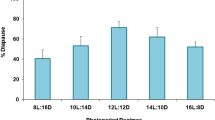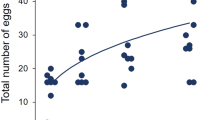Abstract
FLESH flies (Diptera: Sarcophagidae) of the temperate region use the short, cool days of late summer and early autumn as a reliable cue to signal the advent of winter1,2. Flies may enter an overwintering pupal diapause in August, and the adults will not emerge until the following May2. Tropical flies, by contrast, are not exposed to a regularly occurring season of lethal temperatures, and flesh flies from Nairobi, Kenya, have been reared outside throughout the year without the occurrence of diapause (D. L. D., unpublished). Yet four species from equatorial Africa that have been examined, Sarcophaga inzi, S. monospila, Poecilometopa punctipennis and P. spilogaster, have all demonstrated the potential to enter pupal diapause. During diapause in both the temperate1,2 and tropical species, pupal development is halted at the early phaenerocephalic stage.
This is a preview of subscription content, access via your institution
Access options
Subscribe to this journal
Receive 51 print issues and online access
$199.00 per year
only $3.90 per issue
Buy this article
- Purchase on Springer Link
- Instant access to full article PDF
Prices may be subject to local taxes which are calculated during checkout
Similar content being viewed by others

References
Fraenkel, G., and Hsiao, C., J. Insect Physiol., 14, 689–705 (1968).
Denlinger, D. L., Biol. Bull. mar. biol. Lab. Woods Hole, 142, 11–24 (1972).
Rohdendorf, B. B., Proc. Ent. Inst. Acad Sci. U.S.S.R., 116, 1–91 (1967).
Author information
Authors and Affiliations
Rights and permissions
About this article
Cite this article
DENLINGER, D. Diapause potential in tropical flesh flies. Nature 252, 223–224 (1974). https://doi.org/10.1038/252223a0
Received:
Issue Date:
DOI: https://doi.org/10.1038/252223a0
This article is cited by
Comments
By submitting a comment you agree to abide by our Terms and Community Guidelines. If you find something abusive or that does not comply with our terms or guidelines please flag it as inappropriate.


